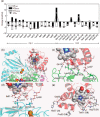Energetic Mechanism of Cytochrome c-Cytochrome c Oxidase Electron Transfer Complex Formation under Turnover Conditions Revealed by Mutational Effects and Docking Simulation
- PMID: 27226541
- PMCID: PMC4946943
- DOI: 10.1074/jbc.M115.708065
Energetic Mechanism of Cytochrome c-Cytochrome c Oxidase Electron Transfer Complex Formation under Turnover Conditions Revealed by Mutational Effects and Docking Simulation
Abstract
Based on the mutational effects on the steady-state kinetics of the electron transfer reaction and our NMR analysis of the interaction site (Sakamoto, K., Kamiya, M., Imai, M., Shinzawa-Itoh, K., Uchida, T., Kawano, K., Yoshikawa, S., and Ishimori, K. (2011) Proc. Natl. Acad. Sci. U.S.A. 108, 12271-12276), we determined the structure of the electron transfer complex between cytochrome c (Cyt c) and cytochrome c oxidase (CcO) under turnover conditions and energetically characterized the interactions essential for complex formation. The complex structures predicted by the protein docking simulation were computationally selected and validated by the experimental kinetic data for mutant Cyt c in the electron transfer reaction to CcO. The interaction analysis using the selected Cyt c-CcO complex structure revealed the electrostatic and hydrophobic contributions of each amino acid residue to the free energy required for complex formation. Several charged residues showed large unfavorable (desolvation) electrostatic interactions that were almost cancelled out by large favorable (Columbic) electrostatic interactions but resulted in the destabilization of the complex. The residual destabilizing free energy is compensated by the van der Waals interactions mediated by hydrophobic amino acid residues to give the stabilized complex. Thus, hydrophobic interactions are the primary factors that promote complex formation between Cyt c and CcO under turnover conditions, whereas the change in the electrostatic destabilization free energy provides the variance of the binding free energy in the mutants. The distribution of favorable and unfavorable electrostatic interactions in the interaction site determines the orientation of the binding of Cyt c on CcO.
Keywords: bioenergetics; cytochrome c; cytochrome c oxidase (complex IV); electron transfer complex; molecular docking.
© 2016 by The American Society for Biochemistry and Molecular Biology, Inc.
Figures





References
-
- Yoshikawa S., and Shimada A. (2015) Reaction mechanism of cytochrome c oxidase. Chem. Rev. 115, 1936–1989 - PubMed
-
- Malmström B. G. (1979) Cytochrome c oxidase. Structure and catalytic activity. Biochim. Biophys. Acta 549, 281–303 - PubMed
-
- Papa S. (1982) Molecular mechanism of proton translocation by the cytochrome system and the ATPase of mitochondria. Role of proteins. J. Bioenerg. Biomembr. 14, 69–86 - PubMed
-
- Brunori M., and Wilson M. T. (1995) Electron transfer and proton pumping in cytochrome oxidase. Biochimie 77, 668–676 - PubMed
-
- Kaila V. R., Verkhovsky M. I., and Wikström M. (2010) Proton-coupled electron transfer in cytochrome oxidase. Chem. Rev. 110, 7062–7081 - PubMed
Publication types
MeSH terms
Substances
Associated data
- Actions
- Actions
LinkOut - more resources
Full Text Sources
Other Literature Sources

